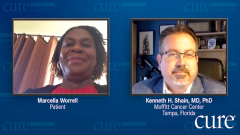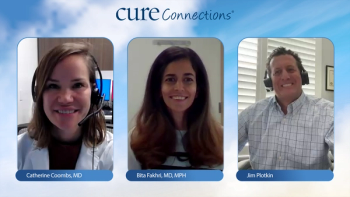
Multiple Myeloma: Working Together to Decide on Treatment
A discussion of how patients and physicians can work together to decide on the best individualized treatment option for multiple myeloma.
Episodes in this series

Kenneth H. Shain, M.D., Ph.D.: Another thing to think about whenever someone is starting new therapy is what are the options that are available to us and the patient in front of us. If it’s a relapsed patient or relapsed state, what have our prior therapies done from a toxicity perspective?
To put that in a little more perspective, in Marcella’s case, if we think about her relapse, she’s been off therapy for over seven years. And so the thought process is her disease will be relatively sensitive to therapies. We want to think about something that’s going to be able to get her back under control very quickly with a good amount of tolerance. Going backward, we know she struggled with Velcade. She had lots of neuropathy from Velcade, and as it turns out, even a little of the Revlimid was contributing as well. So Velcade is something we don’t want to think about. The class of drug works really well, but that drug itself and that side effect is not something we want to think about for Marcella or someone like Marcella. We want to keep that in mind.
Revlimid did a really good job as well. The question of how tolerable it was cramp-wise is something we have to keep in mind. Can we try a slightly lower dose to avoid those things and make that part of our therapy? But from the perspective of what’s available, at the time we had a brand new drug called Darzalex that, in my mind, is really effective. It has really good data in the early relapse setting, whether it’s partnered with pomalidomide, or lenalidomide, or a proteasome inhibitor. We chose Kyprolis in this case because of the toxicities of prior Velcade. You think about that for a number of reasons. It becomes what I think of as an easy regimen over time, being a monthly dosing. The side effects are usually seen only up front with therapy with the initial infusion or injection. Kyprolis has side effects we have to think about, but no neuropathy makes it very attractive.
In Marcella’s case, we learned that Revlimid was not tolerable. Even the cousin to Revlimid, pomalidomide, wasn’t tolerable, so we have that history. That’s one of the ways we would bring those therapies in. It’s taking into account the data, meaning how efficacious or effective is it, how toxic it’s going to be to the patient based on their set of prior side effects and what we know about them, and how well or how fit they are. Those are things that go into it. And then when you’re talking about myeloma, you always want to think about therapies that can be “friendly” with time, to make it as easy [as possible for the patients] to entwine and integrate into their daily activities, where the maintenance therapy is going to be relatively friendly.
Those are the things that go into it from my perspective. Could we have gone with other options for Marcella at the time? Absolutely. Those are things that went into our decision. It’s going to be interesting. Marcella, that’s what I get from my side. That’s what I’m thinking about when I walk in the room. What are the options? What do I know about you? I’d like to switch to your perspective as to what you’re thinking when one of us is talking to you about the options you have for therapy. Are you are you saying, “These are the things I want to get out of it,” or are you saying, “Huh?” Do you mind walking us through that a little?
Marcella Worrell: In the beginning, if my doctor asked me that, I would say, “I don’t know. I’m not sure. What do you think works best?” I would ask him that, like with the Revlimid. But after I was on it, I decided it wasn’t working for me. That’s when I had to talk to him about that. That’s when we tried all the other options. I would first ask him. Since I’ve never been on that or don’t know much about it, I would ask my doctor to recommend what he thinks is the best, which is what I did with [Daniel] Spitz, [M.D., FACP,] and then I went from there.
Kenneth H. Shain, M.D., Ph.D.: When you’re making these decisions and asking for advice because we’re supposed to know a bit, do you think about, “Dr. Spitz, Dr. Shain, how often do I have to come in? Are there drugs I can take as a pill and not have to come in?” Are these things that roll through your mind? Are those things you think about, or are you more focused on, “OK, this is a good idea. Can you give me evidence they’re going to be good for me and I can tolerate these things?”
Marcella Worrell: Yes. I asked him how often I have to take the pills, especially when he was telling me the seven days, the 21 days, and then the one week off. After I started it, I said, “I have to work. Will I be able to work?” Because in the beginning, I was out of work for almost a year, but my insurance and colleagues at the post office donated a lot of leave to me, which helped me stay out of work for that year. Now I know exactly what it entails. So even if I miss one or two days a week, I’m still able to work enough to take care of things.
When I spoke to Dr. Spitz this time around, I said, “Will I be able to work?” That was my first concern. “Will I be able to continue and not have to be out for a whole year again?” He said no starting the first set of Revlimid, but then I told him, “No, my feet, it’s happening again. I don’t want to be on Revlimid. Is there anything else we could try?” We went on to doing the other regimens, which is working very well.
Kenneth H. Shain, M.D., Ph.D.: Exactly. It’s working very well and tolerated very well, so we like that.
Marcella Worrell: Yes. It’s tolerated.
Kenneth H. Shain, M.D., Ph.D.: I have a question little more specific to you and your way of thinking. When we discuss new therapies for you, we give you a high-level view of what the potential toxicities are. We don’t go through 25 pages of all the potential toxicities. Do you worry about those things? Do you just say, “OK, this is what we expect, the major ones to look out for?” Are you someone who then goes back and looks at all the bad things that can happen to you?
Marcella Worrell: Once we decide on one thing, he gives me a flyer or leaflet to read up on what will and won’t happen. With the first set with Pomalyst, I was getting headaches, so I told him about that. I said, “I’m getting some bad headaches,” and that’s when we decided to switch off of that and go on to other things. But yes, I read up on every one of them to see what the side effects would be, how I would handle them. Then I talked to him about if it did happen. Most of them didn’t.
Kenneth H. Shain, M.D., Ph.D.: You said two really important things in that last sentence. One is that you never had most of those side effects, but it’s still important to be your own advocate and educate yourself so you know what to look out for and what you can ask your physicians about.
You’ve been through a long journey, and we’re going to continue this journey. We’re going to talk about other things to do. When you and I met last time, we talked about the chess match of myeloma. We’re doing really well now, but we also still want to think about our future plans and what we can do. One of the things we talked about was immunotherapies, right?
Marcella Worrell: Yes.
Kenneth H. Shain, M.D., Ph.D.: We’ll talk more about those as we need to, but with CAR [chimeric antigen receptor]-T cell therapy, or immunotherapies, there’s a whole new category of therapy to control your disease where we get your own immune system trained a little to then come back and get rid of the bad guys the best we can. Those are all things that are in our wheelhouse, as well as other therapies. We talked about trials, both for CAR-T cell therapy and outside of that. We also want to make sure we keep as open-minded about that as we can because we want to offer you as many things as we can.
We also talked about other standard-of-care therapies, too, because there’s been a whole bunch of approvals out there in the last couple of years with new therapies and combinations in myeloma. Although you’ve been through three lines of therapy, if you count the Revlimid and pomalidomide in between that didn’t have a chance to work because they weren’t tolerated very well. They were still a line of therapy. Now we have a very successful line, so we need to make sure we continue to think about this chess match. That’s what I talk about, right?
Marcella Worrell: Yes.
Kenneth H. Shain, M.D., Ph.D.: It’s looking at the next move and what’s going to happen if we can’t do exactly that. It’s really important for us to always make sure we mention that this is an ongoing dynamic. As long as you’re doing well, our expectation should be that we’ll have many more lines of therapy to go through, right?
Marcella Worrell: Right. Hopefully one will make it not come back at all.
Kenneth H. Shain, M.D., Ph.D.: We’ll always work on that. I told you from the very beginning that no matter what I tell you, your job is to prove me wrong and do better than however I say you’re going to do.
Marcella Worrell: That’s right.
Kenneth H. Shain, M.D., Ph.D.: And so far, you’ve beat me every time, so you’re winning. I like it.
Transcript edited for clarity.

